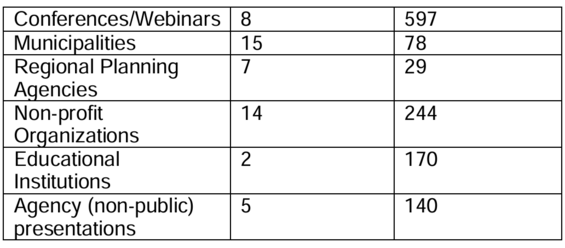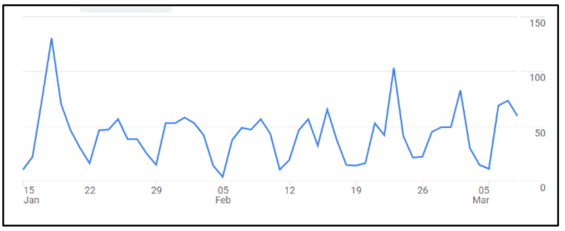The Challenge
Climate change is affecting ecosystems at multiple scales and in novel ways, resulting in a challenge for establishing conservation goals. The new BioMap identifies resilient and vulnerable habitats that need greater prioritization for land protection and resource management and will help to guide efficient prioritization of solutions to mitigate climate change effects (e.g. land protection, habitat management and restoration, infrastructure improvements).
Project Scope
In FY23, two BioMap Outreach Specialists were hired to assist with the rollout of the updated BioMap. Along with the BioMap development team, these contractors worked on a series of outreach activities throughout FY23 and for a portion of FY24 to engage and connect with organizations and communities. They conducted over 50 virtual and in-person presentations to a total number of over 1000 participants (Table 1); corresponded directly with users to make them aware of the update and answer any questions; and provided technical assistance as requested. New resources such as BioMap Town Reports were also created for each municipality and shared with users. Finally, an article which highlighted how BioMap is being used 1 year after it’s release was published in the 2023 winter edition of Massachusetts Wildlife Magazine and reached over 16,000 subscribers.
Metrics
Outreach specialists tracked participation at roll-out activities. The number of BioMap presentations, and participants by audience type, held in FY23 are reported below (Table 1). Participation varied by event and audience type. For example, a conservation commission presentation usually has an audience of 5-20 people, while a webinar or conference audience (advertised to a broader coalition of users) would have an audience of 20 up to 200.

Table 1. - Number of BioMap presentations, and participants by audience type, held in FY23.
Google Analytics also provided data on daily usership of BioMap and user trends over time (Figure 1). The number of users is a good indicator of general website traffic. The main goal is to keep a consistent usership comprised of a multifaceted audience. Not everyone will use BioMap every day, but if enough people know about BioMap and how to use it, a consistent usership will develop. Looking at the near term, another metric to gauge the impact of BioMap will be the number of Open Space and Recreation Plans (OSRPs) that include BioMap. Most municipalities create OSRPs and while some towns are currently incorporating BioMap, continued outreach should increase this number. Finally, the longest-term metric to assess BioMap’s efficacy is the number of acres conserved within the mapped BioMap areas. As reference, 62% of the over 200,000 acres of protected land between 2009 (the release of BioMap2 was in 2010) and 2022 were within BioMap2 areas; ideally this trend will continue, especially given the Commonwealth’s latest commitment to increase the pace of conservation.

Figure 1. - An example of Google Analytics data from mid-January 2023 through early March 2023. The peak on January 18 is when the BioMap webinar took place. The peak on February 23 is when BioMap was presented at the Open Space Conference.
Results
BioMap enables users to apply data in a variety of ways to meet climate change resiliency goals and guide the strategic protection and stewardship of the lands and waters that are most important for conserving biodiversity. Users of BioMap can download data, view an interactive map, and query data to prepare grant applications and inform conservation planning efforts, find recommendations on habitat restoration, and more. We have been able to provide different user groups with additional support and resources to engage with and understand BioMap data, ensuring that BioMap meets the diverse needs of users. These efforts facilitate greater conservation gains and help build a shared vision for biodiversity conservation within the Commonwealth.
Reactions to the updated BioMap have been overwhelmingly positive. Users are excited about the additions of local and regional data, especially in the context of both municipal and regional planning. The new interactive map and features such as the summary report tool have also received similarly positive reactions and are consistently utilized. Users are also encouraged by the presence of dedicated BioMap staff for answering questions and providing detailed technical assistance.
Best Practices and Lessons Learned
When working with municipalities, it is important to remember that each town in the Commonwealth is unique. They often have different interests, needs, and ways of approaching conservation. For example, some towns in more rural regions of the state might be focused on preserving their rural character, while others might want to attract potential development to bolster their economy. Researching each town before meeting with them and creating individualized examples of how they can use the BioMap data to support their conservation efforts creates a stronger connection with the town and prompts an increased interest from boards such as conservation commissions, planning boards, and open space committees.
Another lesson that continues to resonate in the BioMap outreach effort is considering how the BioMap audience can expand. In past iterations, BioMap’s audience has been primarily conservation-oriented non-profit organizations and roughly 60% of Massachusetts municipalities. Efforts over the past years to expand the BioMap audience and user groups included reaching out to educators and focusing on connecting with more urban cities and towns. For example, the BioMap Outreach team presented at the Massachusetts Environmental Education Society conference this past spring to identify opportunities for educators to incorporate BioMap into their curricula. The team also met with Zoo New England and the Urban Ecology group at MassAudubon to build a foundation for future BioMap outreach efforts in urban environments.
Project Alignment with ResilientMass Plan Priority Actions
Updates to BioMap were first identified as a priority action in the 2018 State Hazard and Mitigation and Climate Adaptation Plan. BioMap updates were expanded since then to address ResilientMass Plan priority actions relating to natural resource conservation, including the protection of climate change refugia and habitats important to biodiversity, curtailment of invasive species, and collaboration with Environmental Justice communities.
Further Action
Next steps include increasing the resources available to users. Both BioMap Outreach Specialists moved on to new positions during FY24. The funding for this effort has been extended through FY25 to hire a contractor to complete additional improvements and content for the BioMap Habitat Restoration Resource Center; highlighting the role that restoration efforts play in achieving conservation and resiliency goals in the Commonwealth. Additionally, the BioMap Technical Report will be finalized, which will describe methods used in data selection and analysis, and incorporation of feedback received during outreach activities. BioMap data can also be used in additional analyses to support ongoing EEA efforts to inventory carbon stocks based on landcover, as well as coastal resiliency planning such as salt marsh restoration projects. BioMap will play a critical role in the implementation of Executive Order 618 which tasked the Department of Fish and Game to set bold biodiversity goals for 2030, 2040, and 2050 for Massachusetts. Finally, BioMap will be incorporated into the 2025 State Wildlife Action Plan as a key planning and prioritization tool for conserving imperiled species and their habitats in Massachusetts.
Additional Information and Resources
BioMap represents an ongoing effort by MassWildlife and The Massachusetts Chapter of the Nature Conservancy and is designed to be a dynamic product that will continue to evolve with the availability of new information. BioMap represents a long-term commitment to engaging with conservation practitioners and elevating land and water conservation in the Commonwealth. Access the BioMap Hubsite.
BioMap represents an ongoing effort by MassWildlife and The Massachusetts Chapter of the Nature Conservancy and is designed to be a dynamic product that will continue to evolve with the availability of new information. BioMap represents a long-term commitment to engaging with conservation practitioners and elevating land and water conservation in the Commonwealth. Access the BioMap Hubsite.